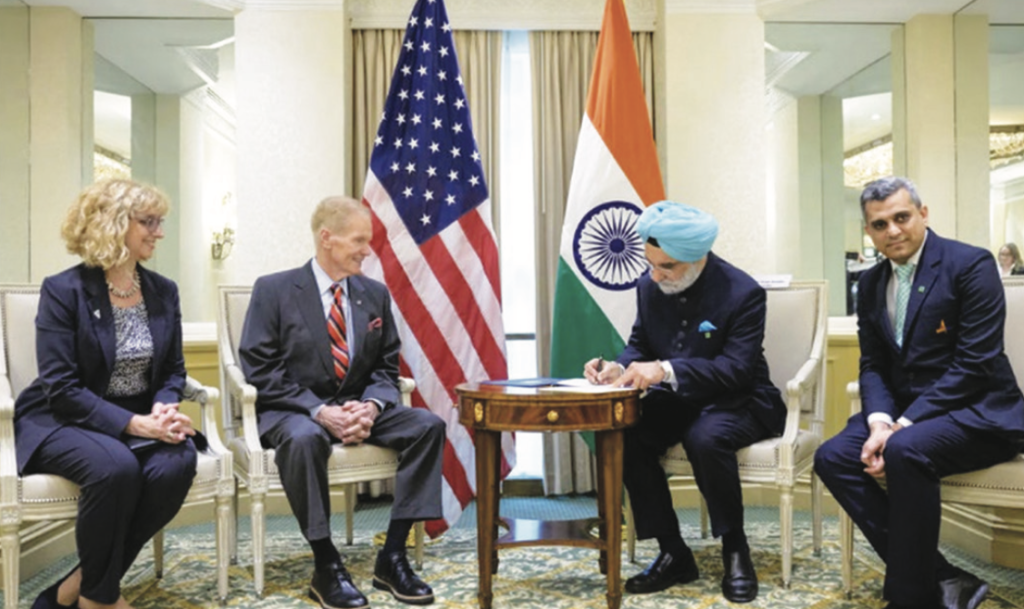In a historic moment, India officially signed the Artemis Accords, cementing its position as the 27th country to join the US-led lunar exploration project. The signing ceremony took place during Prime Minister Narendra Modi’s visit to Washington, D.C., and was officially signed by NASA Administrator Bill Nelson and Indian Ambassador to the United States Taranjit Singh Sandhu.
The Artemis Accords are a set of principles governing international cooperation in the exploration of the Moon. They were developed by the United States in 2020, and they are designed to ensure that lunar exploration is conducted in a safe, sustainable, and transparent manner. The signing of the accords was also a major win for the United States, which has been eager to build international support for its lunar ambitions. India is a major spacefaring nation with a growing space program, and its participation in the Artemis program is a significant boost for the US. This groundbreaking decision holds immense significance for India’s private space industry and presents a range of opportunities. The Artemis Accords are a set of principles governing the exploration of the Moon and other celestial bodies. They are designed to ensure that space exploration is conducted in a safe, sustainable, and transparent manner. The accords also promote the peaceful use of space and the sharing of scientific data.
India’s decision to sign the Artemis Accords is a significant development in the country’s space program. It signals India’s commitment to international cooperation in space exploration and its willingness to abide by the principles of responsible spacefaring. However, it is essential to critically analyse the Accord and its implications while considering its counter to China and Russia’s plans. Additionally, we must examine how the Artemis Accords align with India’s “Make in India” initiative and explore the impact on India’s future space programs and projects.
A Leap Towards New Horizons
The Artemis Accords signify India’s commitment to exploring the moon & beyond new frontiers and contributing to humanity’s collective knowledge of space. By joining this international initiative, India is demonstrating its technological prowess and strengthening its position as a global space power. As the global space economy expands, new verticals like the cislunar and lunar markets are emerging. India is aiming to increase its share in the global space economy from 2% to over 10% by 2035, must look beyond satellite and downstream applications. To achieve this ambitious goal, India needs a comprehensive roadmap for lunar missions and space resource utilization.
Gateway for the Indian Private Space Industry
The Artemis Accords open up a plethora of opportunities for India’s private space industry. Collaborating with NASA and other international partners, Indian companies can actively participate in lunar missions, offering services, technology, and expertise. This involvement will fuel innovation, research, and development in India’s space sector, fostering growth and competitiveness. One notable aspect of the Artemis program is the involvement of startups and private industries. Contracts worth over $700 million have already been awarded to these entities under the CLPS program.
A Counter to China and Russia
The joint International Lunar Research Station (ILRS) between China and Russia emerges as a rival to NASA’s Artemis program, representing a collaborative effort to establish a research outpost on the Moon. These developments underscore the increasing competition and global interest in lunar exploration, as countries vie for scientific discoveries, resource utilization, and strategic advantages in space exploration. India’s decision to join the Artemis Accords carries Geopolitical significance, particularly in the context of countering China and Russia’s space ambitions. China has been rapidly developing its space program in recent years, and it is now a major player in the global space race. Russia is also a major space power, and it has been cooperating with China on a number of space projects. China’s lunar exploration program and Russia’s plans for lunar bases have raised concerns among the international community. By aligning with the United States and other like-minded nations, India reinforces a collaborative approach and safeguards its interests in space exploration.
Advantages for the “Make in India” Initiative
The Artemis Accords align harmoniously with India’s flagship initiative, “Make in India.” The agreement provides opportunities for Indian industries to collaborate with global partners in developing cutting-edge space technologies, manufacturing components, and contributing to the construction of lunar infrastructure. This collaboration will enhance India’s self-reliance in the space sector and create employment opportunities.
Artemis Accords vs Outer Space Treaty
India’s decision to join the Artemis Accords also sheds light on the fundamental differences between the accords and the Moon Treaty. While the Artemis Accords emphasize the utilization and extraction of lunar resources. India’s alignment with the Artemis Accords reflects a pragmatic approach that acknowledges the importance of utilizing space resources for sustainable exploration and development.
The Artemis Accords have been criticized by some experts who argue that they violate the Outer Space Treaty, which was signed by 113 countries in 1967. The Outer Space Treaty prohibits the militarization of space and the appropriation of any celestial body.
While the Artemis Accords do not explicitly violate the Outer Space Treaty, but they do allow for the commercial exploitation of space resources. This has led some experts to argue that the accords could lead to the privatization of the moon and the exploitation of its resources by a few wealthy countries. Others argue that the accords are too focused on the United States and its allies, and that they do not do enough to promote international cooperation.
It is crucial to tread cautiously amidst the disparities between the Moon Treaty and the Artemis Accords. While the Artemis Accords, as outlined in Section 3 (Peaceful Purposes) and Section 9 (Preserving Outer Space Heritage), do promote and provide provisions for the exploration of lunar resources, the Moon Treaty explicitly emphasizes the concept of the common heritage of mankind and the peaceful utilization of space.
At present, both the Artemis Accords and the policy indicate the extraction of resources from asteroids. However, it is essential for us to establish a clear stance on whether we prioritize the pragmatic aspects of outer space, lunar, and asteroid exploration for resources or uphold the idealistic belief in the inheritance of mankind.
It is too early to say whether the Artemis Accords will violate the Outer Space Treaty and have raised important questions about the future of space exploration and the role of international law in governing space activities. However, the Artemis Accords have also been praised by many experts and maintain the accords are a necessary step to ensure the safe and sustainable exploration of the Moon and the accords are compatible with the Outer Space Treaty, and it will actually help to promote international cooperation in space.

Impact on India’s Space Programs and Projects
Primarily led by the Indian Space Research Organisation (ISRO), India’s space endeavours have achieved remarkable milestones and contributed to the country’s overall development. Joining the Artemis Accords will have a transformative impact on India’s space programs and projects. Collaborative ventures with NASA and international partners will enhance India’s scientific capabilities, technological advancements, and knowledge-sharing. For starters, there are plans for NASA to dispatch an Indian astronaut to the International Space Station (ISS) in 2024. Additionally, the joint NASA-ISRO Synthetic Aperture Radar (NISAR) Earth science mission is on track and expected to be launched by ISRO in the early months of 2024.
Presently, India’s sojourns to the moon and Mars have been completely independent. This has definitely resulted in the independent growth of capabilities and capacities. However, as India aspires to be a part of the leading spacefaring nations in the world and carry out explorations to the moon, Mars, and beyond, as well as consider the colonization of the moon and much more, it will not be able to carry out all these activities independently due to the high costs involved, as well as the multitude of new scientific research and technologies involved. A more pragmatic approach would be to do it in cooperation with like-minded spacefaring nations. Maybe a more pragmatic approach for the future. Of course, this should in no way curtail or stop our independent exploration of space. The Artemis agreement definitely places us in the camp of US-led spacefaring nations. However, in the current global environment where the other two leading spacefaring nations provide no opportunity—Russia due to its greatly reduced financial capacities while China is a defined adversary—this is the best option.
India already has moon project titled the Chandrayaan. Chandrayaan 1, 2, and the upcoming Chandrayaan 3 are significant milestones in India’s space exploration endeavours, showcasing the country’s technological prowess and ambition in lunar missions. This partnership will accelerate the development of critical technologies, such as lunar landers, habitats, and resource utilization methods, positioning India at the forefront of space exploration. The accords are also likely to lead to the development of new technologies and the creation of jobs in the Indian space sector. This could help to boost the Indian economy and make the country a more attractive destination for investment.
Conclusion
India’s decision to sign the Artemis Accords represents a strategic move towards enhancing its presence in space exploration and technological advancement. It is imperative that, in addition to the Artemis accords, our independent research and exploration of outer space maintain its position as a frontrunner in the realm of space. By joining this US-led initiative, India’s private space industry stands to gain significant opportunities, bolstering its growth and competitiveness. Furthermore, the accord allows India to counter the space plans of China and Russia while aligning with its “Make in India” initiative. The Artemis Accords provide a platform for India to contribute to lunar exploration, leverage resources sustainably, and collaborate on pioneering technologies. This historic decision signifies India’s commitment to space exploration and reinforces its position as a global space power.
Lieutenant General AK Bhatt, PVSM, UYSM, AVSM, SM, VSM (Retd) is currently the Director General of the Indian Space Association (ISpA). has held Apex leadership and management positions in the Indian Army including being the Military Secretary and Director General military Operations at the Army Headquarters and has commanded the Chinar Corps in J&K.


